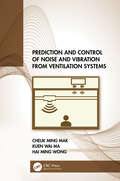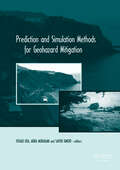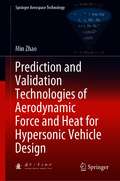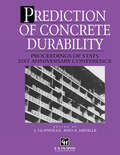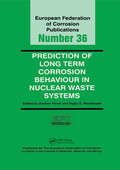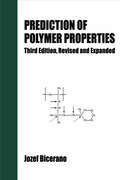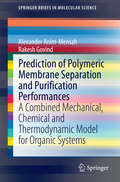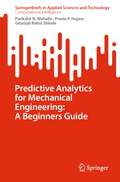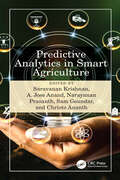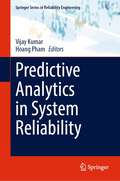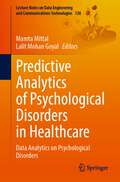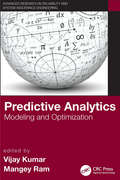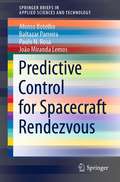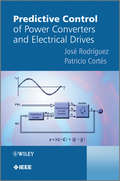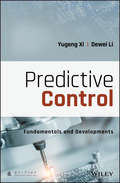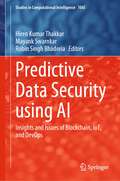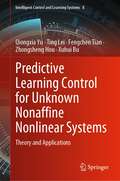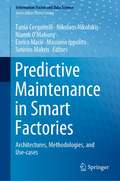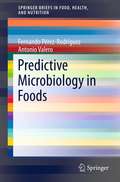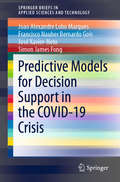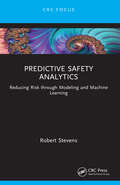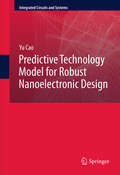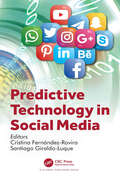- Table View
- List View
Prediction and Control of Noise and Vibration from Ventilation Systems
by Cheuk Ming Mak Kuen Wai Ma Hai Ming WongThis book addresses the prediction and control of noise and vibration in ventilation systems and their psychoacoustic effects on people. The content is based on the authors’ research and lecture material on building acoustics and provides insights into the development of prediction methods and control of noise and vibration from ventilation systems, and an assessment of their psychological effects on people. The basic principles and methods for prediction and control of noise and vibration from ventilation systems are discussed, including the latest developments on flow-generated noise prediction, assessment methods for the performance of vibration isolation, noise control using periodic Helmholtz Resonators, and holistic psychoacoustic assessment of noise from ventilation systems. The insightful book on noise and vibration in ventilation systems Extends into prediction, control, and psychoacoustic assessment methods The book suits graduate students and engineers in acoustics and noise and vibration control, as well as in building services engineering and across the built environment.
Prediction and Simulation Methods for Geohazard Mitigation: including CD-ROM
by Akira Murakami Fusao Oka Sayuri KimotoThe last decades have shown a remarkable increase in the number of heavy rains, typhoons and earthquakes. These natural phenomena are the main causes for geohazards. As a result the mitigation of geohazards has become a major research topic in geotechnical engineering, and in recent years simulation-based predictions and monitoring tools have been
Prediction and Validation Technologies of Aerodynamic Force and Heat for Hypersonic Vehicle Design (Springer Aerospace Technology)
by Min ZhaoThis book provides an overview of advanced prediction and verification technologies for aerodynamics and aerothermodynamics and assesses a number of critical issues in advanced hypersonic vehicle design. Focusing on state-of-the-art theories and promising technologies for engineering applications, it also presents a range of representative practical test cases. Given its scope, the book offers a valuable asset for researchers who are interested in thermodynamics, aircraft design, wind tunnel testing, fluid dynamics and aerothermodynamics research methods, introducing them to inspiring new research topics.
Prediction of Concrete Durability: Proceedings of STATS 21st anniversary conference
by J. Glanville A. NevillePoor durability of concrete is a continuing concern to owners of structures and their professional advisors. Advances in methods of assessing and predicting durability are being made in many areas, and this book provides a state of art review of the current situation. Contributions from leading researchers and consultants make it a valuable guide f
Prediction of Long Term Corrosion Behaviour in Nuclear Waste Systems EFC 36 (European Federation of Corrosion Publications)
by Damien FeronPapers presented on prediction of long term corrosion behaviour in nuclear waste systems EFC Issue 36.
Prediction of Polymer Properties (Plastics Engineering)
by Jozef BiceranoHighlighting a broad range multiscale modeling and methods for anticipating the morphologies and the properties of interfaces and multiphase materials, this reference covers the methodology of predicting polymer properties and its potential application to a wider variety of polymer types than previously thought possible. A comprehensive source, the
Prediction of Polymeric Membrane Separation and Purification Performances
by Alexander Anim-Mensah Rakesh GovindThis brief describes the development of a new model for realistically characterizing solution-diffusion transport mechanisms in polymeric membranes that are used for separation and purification of organic solvents. Polymeric membranes used in these environments, if not selected appropriately, undergo excessive swelling and compaction resulting in lowered performance or membrane destruction in the long-term. This brief describes the relationship between key parameters from a chemical, mechanical and thermodynamic perspective. Moreover, the authors show how this new model points membrane manufacturers, scientists, and engineers towards an understanding of how these key parameters are considered in (1) designing and manufacturing membranes for the right application, (2) designing the right test experiments to determine the long-term membrane behavior in a short time, (3) minimizing the number of experiments to determine a reliable membrane for an application and (4) selecting the right membrane with higher level of certainty. The overall benefits of the model includes saving money and time. A simplified version of the model is included to assist the reader.
Predictive Analytics for Mechanical Engineering: A Beginners Guide (SpringerBriefs in Applied Sciences and Technology)
by Parikshit N. Mahalle Gitanjali Rahul Shinde Pravin P. HujareThis book focus on key component required for building predictive maintenance model. The current trend of Maintenance 4.0 leans towards the preventive mechanism enabled by predictive approach and condition-based smart maintenance. The intelligent decision support, earlier detection of spare part failure, fatigue detection is the main slices of intelligent and predictive maintenance system (PMS) leading towards Maintenance 4.0 This book presents prominent use cases of mechanical engineering using PMS along with the benefits. Basic understanding of data preparation is required for development of any AI application; in view of this, the types of the data and data preparation processes, and tools are also presented in this book.
Predictive Analytics in Smart Agriculture
by Saravanan Krishnan Sam Goundar Narayanan Prasanth Christo Ananth A. Jose AnandPredictive Analysis in Smart Agricultureexplores computational engineering techniques and applications in agriculture development. Recent technologies such as cloud computing, IoT, big data, and machine learning are focused on for smart agricultural engineering. The book also provides a case-oriented approach for IoT-based agricultural systems.This book deals with all aspects of smart agriculture with state-of-the-art predictive analysis in the complete 360-degree view spectrum. The book includes the concepts of urban and vertical farming using Agro IoT systems and renewable energy sources for modern agriculture trends. It discusses the real-world challenges, complexities in Agro IoT, and advantages of incorporating smart technology. It also presents the rapid advancement of the technologies in the existing Agri model by applying the various techniques. Novel architectural solutions in smart agricultural engineering are the core aspects of this book. Several predictive analysis tools and smart agriculture are also incorporated.This book can be used as a textbook for students in predictive analysis, agriculture engineering, precision farming, and smart agriculture. It can also be a reference book for practicing professionals in cloud computing, IoT, big data, machine learning, and deep learning working on smart agriculture applications.
Predictive Analytics in System Reliability (Springer Series in Reliability Engineering)
by Hoang Pham Vijay KumarThis book provides engineers and researchers knowledge to help them in system reliability analysis using machine learning, artificial intelligence, big data, genetic algorithm, information theory, multi-criteria decision making, and other techniques. It will also be useful to students learning reliability engineering.The book brings readers up to date with how system reliability relates to the latest techniques of AI, big data, genetic algorithm, information theory, and multi-criteria decision making and points toward future developments in the subject.
Predictive Analytics of Psychological Disorders in Healthcare: Data Analytics on Psychological Disorders (Lecture Notes on Data Engineering and Communications Technologies #128)
by Mamta Mittal Lalit Mohan GoyalThis book discusses an interdisciplinary field which combines two major domains: healthcare and data analytics. It presents research studies by experts helping to fight discontent, distress, anxiety and unrealized potential by using mathematical models, machine learning, artificial intelligence, etc. and take preventive measures beforehand. Psychological disorders and biological abnormalities are significantly related with the applications of cognitive illnesses which has increased significantly in contemporary years and needs rapid investigation. The research content of this book is helpful for psychological undergraduates, health workers and their trainees, therapists, medical psychologists, and nurses.
Predictive Analytics: Modeling and Optimization (Advanced Research in Reliability and System Assurance Engineering)
by Edited by Vijay Kumar and Mangey RamPredictive analytics refers to making predictions about the future based on different parameters which are historical data, machine learning, and artificial intelligence. This book provides the most recent advances in the field along with case studies and real-world examples. It discusses predictive modeling and analytics in reliability engineering and introduces current achievements and applications of artificial intelligence, data mining, and other techniques in supply chain management. It covers applications to reliability engineering practice, presents numerous examples to illustrate the theoretical results, and considers and analyses case studies and real-word examples. The book is written for researchers and practitioners in the field of system reliability, quality, supply chain management, and logistics management. Students taking courses in these areas will also find this book of interest.
Predictive Control for Spacecraft Rendezvous (SpringerBriefs in Applied Sciences and Technology)
by Afonso Botelho Baltazar Parreira Paulo N. Rosa João Miranda LemosThis brief addresses the design of model predictive control algorithms for performing space rendezvous manoeuvres. It consolidates developments within guidance and control algorithms, with the aim of improving the efficiency, safety, and autonomy of these manoeuvres. The brief presents several applications of model predictive control to rendezvous manoeuvres, including Ankersen zero-order-hold particular solution1, which provides a realistic thrust profile. It offers new approaches for rendezvous manoeuvres in elliptical orbits, formulating obstacle avoidance constraints, passive safety constraints, and robustness techniques. It also compares finite-horizon and variable-horizon formulations for model predictive control in the context of performance and computational complexity. Predictive Control for Spacecraft Rendezvous is accessible to academics and students new to the topics of orbital rendezvous and model predictive control, but also presents compelling subject matter for researchers and professionals in the aerospace industry.
Predictive Control of Power Converters and Electrical Drives
by Patricio Cortes Jose RodriguezDescribes the general principles and current research into Model Predictive Control (MPC); the most up-to-date control method for power converters and drivesThe book starts with an introduction to the subject before the first chapter on classical control methods for power converters and drives. This covers classical converter control methods and classical electrical drives control methods. The next chapter on Model predictive control first looks at predictive control methods for power converters and drives and presents the basic principles of MPC. It then looks at MPC for power electronics and drives. The third chapter is on predictive control applied to power converters. It discusses: control of a three-phase inverter; control of a neutral point clamped inverter; control of an active front end rectifier, and; control of a matrix converter. In the middle of the book there is Chapter four - Predictive control applied to motor drives. This section analyses predictive torque control of industrial machines and predictive control of permanent magnet synchronous motors. Design and implementation issues of model predictive control is the subject of the final chapter. The following topics are described in detail: cost function selection; weighting factors design; delay compensation; effect of model errors, and prediction of future references. While there are hundreds of books teaching control of electrical energy using pulse width modulation, this will be the very first book published in this new topic.Unique in presenting a completely new theoretic solution to control electric power in a simple wayDiscusses the application of predictive control in motor drives, with several examples and case studiesMatlab is included on a complementary website so the reader can run their own simulations
Predictive Control: Fundamentals and Developments
by Yugeng Xi Dewei LiThis book is a comprehensive introduction to model predictive control (MPC), including its basic principles and algorithms, system analysis and design methods, strategy developments and practical applications. The main contents of the book include an overview of the development trajectory and basic principles of MPC, typical MPC algorithms, quantitative analysis of classical MPC systems, design and tuning methods for MPC parameters, constrained multivariable MPC algorithms and online optimization decomposition methods. Readers will then progress to more advanced topics such as nonlinear MPC and its related algorithms, the diversification development of MPC with respect to control structures and optimization strategies, and robust MPC. Finally, applications of MPC and its generalization to optimization-based dynamic problems other than control will be discussed. Systematically introduces fundamental concepts, basic algorithms, and applications of MPC Includes a comprehensive overview of MPC development, emphasizing recent advances and modern approaches Features numerous MPC models and structures, based on rigorous research Based on the best-selling Chinese edition, which is a key text in China Predictive Control: Fundamentals and Developments is written for advanced undergraduate and graduate students and researchers specializing in control technologies. It is also a useful reference for industry professionals, engineers, and technicians specializing in advanced optimization control technology.
Predictive Cruise Control for Road Vehicles Using Road and Traffic Information (Advances in Industrial Control)
by Péter Gáspár Balázs NémethThis book focuses on the design of a multi-criteria automated vehicle longitudinal control system as an enhancement of the adaptive cruise control system. It analyses the effects of various parameters on the average traffic speed and the traction force of the vehicles in mixed traffic from a macroscopic point of view, and also demonstrates why research and development in speed control and predictive cruise control is important. The book also summarises the main steps of the system’s robust control design, from the modelling to its synthesis, and discusses both the theoretical background and the practical computation method of the control invariant sets.The book presents the analysis and verification of the system both in a simulation environment and under real-world conditions. By including the systematic design of the predictive cruise control using road and traffic information, it shows how optimization criteria can lead to multiobjective solutions, and the advanced optimization and control design methods required. The book focuses on a particular method by which the unfavourable effect of the traffic flow consideration can be reduced. It also includes simulation examples in which the speed design is performed, while the analysis is carried out in simulation and visualization environments.This book is a valuable reference for researchers and control engineers working on traffic control, vehicle control and control theory. It is also of interest to students and academics as it provides an overview of the strong interaction between the traffic flow and an individual vehicle cruising from both a microscopic and a macroscopic point of view.
Predictive Data Security using AI: Insights and Issues of Blockchain, IoT, and DevOps (Studies in Computational Intelligence #1065)
by Robin Singh Bhadoria Hiren Kumar Thakkar Mayank SwarnkarThis contributed volume consists of 11 chapters that specifically cover the security aspects of the latest technologies such as Blockchain, IoT, and DevOps, and how to effectively deal with them using Intelligent techniques. Moreover, machine learning (ML) and deep learning (DL) algorithms are also not secured and often manipulated by attackers for data stealing. This book also discusses the types of attacks and offers novel solutions to counter the attacks on ML and DL algorithms. This book describes the concepts and issues with figures and the supporting arguments with facts and charts. In addition to that, the book provides the comparison of different security solutions in terms of experimental results with tables and charts. Besides, the book also provides the future directions for each chapter and novel alternative approaches, wherever applicable. Often the existing literature provides domain-specific knowledge such as the description of security aspects. However, the readers find it difficult to understand how to tackle the application-specific security issues. This book takes one step forward and offers the security issues, current trends, and technologies supported by alternate solutions. Moreover, the book provides thorough guidance on the applicability of ML and DL algorithms to deal with application-specific security issues followed by novel approaches to counter threats to ML and DL algorithms. The book includes contributions from academicians, researchers, security experts, security architectures, and practitioners and provides an in-depth understanding of the mentioned issues.
Predictive Dialing Fundamentals: An Overview of Predictive Dialing Technologies, Their Applications, and Usage Today
by Aleksander Szlam Ken ThatcherWho should read this book? This is a must read if you're a newcomer to predictive dialers and responsible for analyzing, recommending and deploying inbound and outbound call center solutions; or, if you're in the midst of implementing a predictive dialer,
Predictive Learning Control for Unknown Nonaffine Nonlinear Systems: Theory and Applications (Intelligent Control and Learning Systems #8)
by Ting Lei Zhongsheng Hou Qiongxia Yu Fengchen Tian Xuhui BuThis book investigates both theory and various applications of predictive learning control (PLC) which is an advanced technology for complex nonlinear systems. To avoid the difficult modeling problem for complex nonlinear systems, this book begins with the design and theoretical analysis of PLC method without using mechanism model information of the system, and then a series of PLC methods is designed that can cope with system constraints, varying trial lengths, unknown time delay, and available and unavailable system states sequentially. Applications of the PLC on both railway and urban road transportation systems are also studied. The book is intended for researchers, engineers, and graduate students who are interested in predictive control, learning control, intelligent transportation systems and related fields.
Predictive Maintenance in Smart Factories: Architectures, Methodologies, and Use-cases (Information Fusion and Data Science)
by Tania Cerquitelli Nikolaos Nikolakis Niamh O’Mahony Enrico Macii Massimo Ippolito Sotirios MakrisThis book presents the outcome of the European project "SERENA", involving fourteen partners as international academics, technological companies, and industrial factories, addressing the design and development of a plug-n-play end-to-end cloud architecture, and enabling predictive maintenance of industrial equipment to be easily exploitable by small and medium manufacturing companies with a very limited data analytics experience. Perspectives and new opportunities to address open issues on predictive maintenance conclude the book with some interesting suggestions of future research directions to continue the growth of the manufacturing intelligence.
Predictive Microbiology in Foods
by Antonio Valero Fernando Perez-RodriguezPredictive microbiology is a recent area within food microbiology, which studies the responses of microorganisms in foods to environmental factors (e.g., temperature, pH) through mathematical functions. These functions enable scientists to predict the behavior of pathogens and spoilage microorganisms under different combinations of factors. The main goal of predictive models in food science is to assure both food safety and food quality. Predictive models in foods have developed significantly in the last 20 years due to the emergence of powerful computational resources and sophisticated statistical packages. This book presents the concepts, models, most significant advances, and future trends in predictive microbiology. It will discuss the history and basic concepts of predictive microbiology. The most frequently used models will be explained, and the most significant software and databases (e.g., Combase, Sym'Previus) will be reviewed. Quantitative Risk Assessment, which uses predictive modeling to account for the transmission of foodborne pathogens across the food chain, will also be covered.
Predictive Models for Decision Support in the COVID-19 Crisis (SpringerBriefs in Applied Sciences and Technology)
by Simon James Fong Joao Alexandre Marques Francisco Nauber Gois José Xavier-NetoCOVID-19 has hit the world unprepared, as the deadliest pandemic of the century. Governments and authorities, as leaders and decision makers fighting the virus, enormously tap into the power of artificial intelligence and its predictive models for urgent decision support. This book showcases a collection of important predictive models that used during the pandemic, and discusses and compares their efficacy and limitations. Readers from both healthcare industries and academia can gain unique insights on how predictive models were designed and applied on epidemic data. Taking COVID19 as a case study and showcasing the lessons learnt, this book will enable readers to be better prepared in the event of virus epidemics or pandemics in the future.
Predictive Safety Analytics: Reducing Risk through Modeling and Machine Learning (Reliability, Maintenance, and Safety Engineering)
by Robert StevensNearly all our safety data collection and reporting systems are backwardlooking: incident reports; dashboards; compliance monitoring systems; and so on. This book shows how we can use safety data in a forward-looking, predictive sense.Predictive Safety Analytics: Reducing Risk through Modeling and Machine Learning contains real use cases where organizations have reduced incidents by employing predictive analytics to foresee and mitigate future risks. It discusses how Predictive Safety Analytics is an opportunity to break through the plateau problem where safety rate improvements have stagnated in many organizations. The book presents how the use of data, coupled with advanced analytical techniques, including machine learning, has become a proven and successful innovation. Emphasis is placed on how the book can “meet you where you are” by illuminating a path to get there, starting with simple data the organization likely already has. Highlights of the book are the real examples and case studies that will assist in generating thoughts and ideas for what might work for individual readers and how they can adapt the information to their particular situations.This book is written for professionals and researchers in system reliability, risk and safety assessment, quality control, operational managers in selected industries, data scientists, and ML engineers. Students taking courses in these areas will also find this book of interest to them.
Predictive Technology Model for Robust Nanoelectronic Design
by Yu CaoPredictive Technology Model for Robust Nanoelectronic Design explains many of the technical mysteries behind the Predictive Technology Model (PTM) that has been adopted worldwide in explorative design research. Through physical derivation and technology extrapolation, PTM is the de-factor device model used in electronic design. This work explains the systematic model development and provides a guide to robust design practice in the presence of variability and reliability issues. Having interacted with multiple leading semiconductor companies and university research teams, the author brings a state-of-the-art perspective on technology scaling to this work and shares insights gained in the practices of device modeling.
Predictive Technology in Social Media
by Cristina Fernández-RoviraCan behaviour on social media predict future purchase patterns? Can what we click on social media foresee which political party will we vote for? Can the information we share on our wall foretell the next series I might want to watch? Can the likes on Instagram and Facebook predict the time one will spend on digital platforms in the next hour? The answer is no longer science fiction. It points to the ability of mainstream social media platforms such as Facebook and Twitter to be able to deliver specialised advertising services to highly targeted audience segments controlled by the billions of devices that flood our daily lives. At the same time, it highlights a more relevant problem: can social media guide, suggest or impose a certain behaviour or thought? Everything seems to indicate that they can do it.Predictive Technology in Social Media comprises 10 essays that reflect on the power of the predictive technology of social media in culture, entertainment, marketing, economics and politics. It shows, from a humanistic and critical perspective, the predictive possibilities of social media platforms, as well as the risks this entails for cultural plurality, everyday consumption, the monopolistic concentration of the economy and attention, and democracy. The text is an invitation to think, as citizens, about the unbridled power we have ceded to digital platforms. A new voice to warn about the greatest concentration of communicative power ever seen in the history of humanity.
